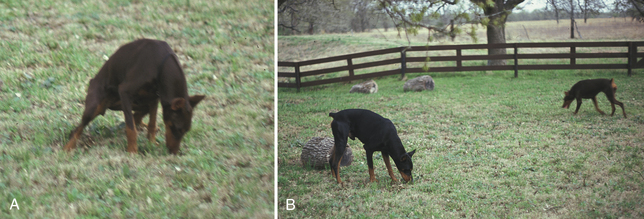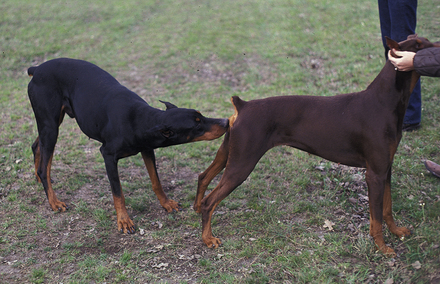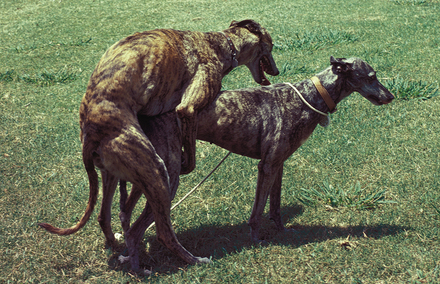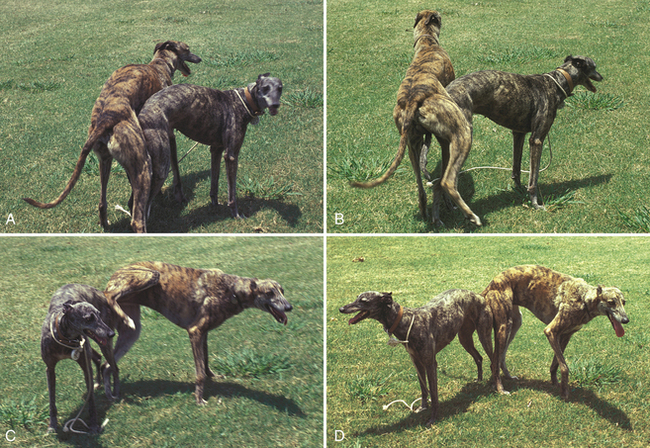CHAPTER 5 Male Canine Sexual Behavior
SEXUAL MATURATION
In males of most species, there is a surge of testosterone within a few days of birth that is responsible for masculinizing the brain, including those areas responsible for the male behaviors. This is called “the organizational effect of the hormone.”53 Without the testosterone influence at this time, the brain remains feminine regardless of which gonads are present. The exact time of this perinatal testosterone surge in male puppies is not well studied,38 but it is known that at birth and for the first 20 days of life, testosterone levels in male puppies are approximately 2 mg/ml versus 0.1 mg/ml in the females.44,48 Thereafter, levels gradually fall and do not rise again until puberty.38,76 These levels do not explain the sexual differences, so it is assumed that the surge occurs prenatally.45 Puppies experimentally castrated during the first few days postpartum and then injected with testosterone for 3 months developed almost the same as noncastrated puppies.6 During the time of injections, these tiny puppies showed a preference for estrous females. This interest continued for at least 20 months. Early castrated puppies show no interest in estrous females unless they receive testosterone injections.
Behaviors such as mounting, pelvic clasps, and thrusts can appear in puppies as young as 3 to 6 weeks.9,14,28,52 Instead of being sexual, however, these behaviors represent play. As with most adult behaviors that occur in puppies, these behaviors are abbreviated and out of context—a part of juvenile play. If puppies are deprived of opportunities to include these behaviors in play, their adult mating behaviors are adversely affected.9,39
Puberty in dogs comes at 6 to 18 months, occurring slightly later in males than in females.9 In wolves puberty occurs at about 2 years.27 In studies of Beagles, the first ejaculation occurred around 33 weeks of age.76 Early ejaculates have large numbers of abnormal spermatozoa, but these numbers soon decrease.76 All characteristics of the fluid part of the ejaculate are comparable with those of adults by 45 weeks of age.76 Light deprivation may slow down maturation of the gonads,55 as might other physical, environmental, and breed factors.28
The development of male behaviors at puberty is the expression of sexual dimorphism. As has already been mentioned, neonatal female puppies have low levels of testosterone, so it is not surprising that females occasionally show behaviors that are typically considered masculine. Part of the “female brain” remains in all males as well, so they can show varying amounts of behavior typically associated with females. Essentially all intact males show sexual mounting, thrusting, and raised-leg urination, but 40% of intact females also show mounting and thrusting, and 5% show raised-leg urination.38,44 Other male traits tend to be dominance over owners, aggression to dogs, territorial defense, destructiveness, playfulness, general activity, and snapping at children.45,46 It also has been shown that testosterone is necessary to produce interest in the vaginal secretions of estrus.1 The distinction between maleness and femaleness is blurred, not absolute.42 Removal of the gonads shifts the dimorphism somewhat toward the opposite sex. Dogs castrated at birth and injected with testosterone as adults will show more masculine behavior than either intact or neutered females but less than dogs castrated after sexual maturity.8,38 The male sexually dimorphic behaviors in dogs include interest in estrous vaginal secretions, mounting, pelvic thrusting, ejaculation, urine marking, roaming, and intermale aggression.36,42
PREMATING (COURTSHIP) BEHAVIOR
Male dogs are considered to be promiscuous breeders and receptive to an estrous bitch at any time of the year.9,27 They may, however, occasionally show a preference for certain bitches, and they are more likely to reject individual females that are dominant or females of other breeds if their contact has been limited to one or two breeds.9,39,77
Premating (courtship) behavior begins when the male first picks up the scent of an estrous bitch. Apparently the odor can travel great distances, because dogs have been found at the home of an estrous female over 5 miles from the fenced yard where they usually stay. When in contact with estrous females, males display a lot of individual variation in behavior. Some show apparent indifference, and some give varied amounts of attention. Most follow the estrous female closely.9,26,28,62 Free-ranging dogs tend to show the most elaborate courtship behaviors. A positive correlation has been found between the number of males attempting to mate and the length of time they show interest in the female.30 In addition, when several males are around a female, they are more aggressive toward each other and tend toward hierarchy formation while she is in heat.17 When the male and female remain close—a behavior called “running together”27—both dogs often show playful interactions including the play bow. He actively noses her ears and shows an increased amount of activity around her.
During the time the male is paying close attention to the female, he continues to be attracted to her reproductive odors (Fig. 5-1). There is a definite preference in male dogs for estrous females and for the urine and vaginal secretions from estrous females, as compared with the eliminative products from anestrous females or males.7,19,21,30,62 He licks the perivulvar area (Fig. 5-2) and the bitch’s urine spots with increased frequency, sampling odors through the vomeronasal organ. Flehmen, difficult to recognize because of the philtrum attaching the lips to the maxilla, may be shown as the dog samples the odors. The male also urine-marks frequently, usually on or near the female’s urine spots.21,56,62 Even then, his attention remains directed toward her.9,28 One explanation for the male’s urinary behaviors at this time is that his urine may help hide the identity or odor trail of the estrous female from other dogs.22 If no estrous female is available, the male is 4 to 20 times more likely to investigate the face, anogenital area, and ears or body of an anestrous female than a male.62
Mounting the estrous bitch occurs directly from the rear 97% of the time by experienced males, but the inexperienced ones and those raised in semi-isolation start at the rear only 39% of the time.3 The rest of the time they start from the side, occasionally from the front, and work their way back.9 How soon mounting will occur after the male finds the estrous female varies. It can be immediate or some time later based on individual and genetic differences in the style of sexual behavior.39 The number of mounts made before mating begins can also vary. Only one mount may be made, or, for some dogs, several attempts.39,57,78 Following a successful mount, the male pulls his forelimbs caudally in a behavior called clasping (Fig. 5-3). This action helps prevent the female from crouching or moving away by minimizing her ability to flex the coxofemoral joints.9 Some males use an inhibited bite of the skin of the female’s neck, the nape bite, as they mount.28
MATING BEHAVIOR
The mating phase of male reproductive behavior begins once the dog has successfully mounted the estrous female. Pelvic thrusts begin, and the glans penis enters the vulva by trial and error.9,38,39 Intromission occurs successfully in 50% to 60% of mounts, unless the dog was raised under semi-isolated conditions. In that case, only 24% of mounts are associated with successful intromission.3 This fact should be considered in cases of unsuccessful reproduction in pets that may have been raised away from other dogs.
Once intromission occurs, the rate of thrusting accelerates until the penis enters the vagina and the bulbus gland becomes fully erect.9,28 At the same time, the constrictor vestibuli muscles of the female contract caudal to the bulbus glandis, and the two dogs are physically joined together in the unique canine event, the “copulatory tie” or “lock.”5,56,78 Only one of 15 males successfully achieves a tie during the first year of life, even after as many as 39 mounts.30 After an intense 15 to 30 seconds of pelvic thrusts, the dog stops thrusting, and ejaculation begins.78 The intense ejaculatory reaction stimulates the male component of the tie, and serum testosterone levels increase.34 Stepping movements by the rear limbs occur and can be quite high during the 15 to 30 seconds of ejaculation.39
Within a minute or so after the pelvic thrusts stop, while the tie is maintained, the male dog will dismount to one side, swing a rear limb over the back of the female, and stand facing in the opposite direction from the female (Fig. 5-4). This action puts a twist in the penis, and the erection is maintained longer because of venous constriction.9,31 The tie will last 10 to 30 minutes or more, during which time both dogs are relatively unresponsive to external activities and usually stand quietly.9,26,28,39,57 Occasionally, a male dog may demonstrate a phantom tie, during which time the dogs stand motionless in a posture typical of a normal tie.5
Ejaculation occurs throughout most of the time the tie is maintained. The sperm-rich portion of ejaculate is usually produced during the first 2 minutes.9,12 The first of three semen fractions in an ejaculate is a clear fluid. The sperm-rich second fraction usually comes during the 50- to 80-second point. The cloudy, white, third fraction comes during the remainder of the tie.12
Success at mating by any individual male depends on many factors, including the number of other males interested in the same female. In fact, a significant negative correlation exists between the number of males interested in a female and the copulatory success rate.30 When one or two males are interested in a female, copulation occurs 75% to 80% of the time within 30 minutes. When three or more are interested, copulation occurs only 5% of the time, and 150 minutes may pass before it occurs.30 Rejection rates of males by estrous females vary from 25% to 80%.30 This rejection can be expressed in many ways, including aggression directed toward an approaching male or the female physically leaving an area.30 When two equally dominant males try to mate, both fail.30 Familiarity between the male and the estrous female is also important in mating success.17
POSTMATING BEHAVIOR
Little physically based behavior occurs immediately after mating. As the venous blood drains from the bulbus glandis, that vascular structure eventually decreases in size until the two dogs are able to slip apart. The male usually licks his penis and prepuce briefly after separating.9,28 Wild male canids may remain with a female through several copulations, perhaps the entire estrous period,26 but human management of dog mating means dogs will show much more variation.
The refractory period is part of the postmating behavior. During this time, the male is not interested in estrous females. How long this disinterest lasts is highly variable and may have both a relatively constant physiologic component and a psychologic one.38 Psychologic factors include how often the male mated in the recent past and whether the estrous female is the same one just mated or represents a novel stimulus. At least over a short period, adult male dogs are usually capable of mating up to five times in 1 day.9,38,52,73 If ejaculation occurs more than once or twice a day, however, the sperm count is cut in half by the fourth ejaculation despite libido remaining high.12 Sperm output is also decreased if ejaculation occurs more than once every other day.12
PARENTAL BEHAVIOR
Parental behavior in male domestic dogs is highly variable. Wild canids often remain close to the female and her young. They may even stand guard during times the mother leaves the immediate area.66 The most common forms of infant care by wild canid males include grooming, playing, bringing escapees back, and resting with the young.63 The male may also regurgitate food for the puppies.66 Sometimes male domesticated dogs will show these behaviors, too. More commonly, however, the male dog is indifferent to the female and her young. Occasionally males will actually attack, and possibly kill, the puppies.26
NEURAL AND HORMONAL REGULATION
Neurologic and Neuromuscular Regulation
Much information about the neurologic regulation of mating behavior has been learned from the cat, so the relevant canine behavior is often presumed rather than studied. The reader is referred to other references for this information.11 In neurologic studies of canine copulatory behavior, researchers have found that lesions of the medial preoptic-anterior hypothalamus reduce mounting by juvenile male dogs and abolish copulatory behavior in adults.37,49 Some of the more specific behaviors have other controls. For example, evidence suggests that the intense ejaculatory reaction and the copulatory tie are completely mediated at the spinal level.32,36,38 Rhythmic contractions of the bulbocavernosus muscle help pump blood from the proximal corpus spongiosum distally, thus facilitating rapid engorgement of the bulbus glandis in the tie.35 At the same time, the ischiourethral muscles contract tonically to facilitate erection by occluding venous return.35 Both engorgement of the bulb and the copulatory tie are prevented if the ischiourethral muscle is severed or nerve function disrupted.35
Ejaculation appears to be inhibited by supraspinal structures and facilitated by neural disinhibition rather than neural excitation during sexual arousal.32 Tactile stimulation of the body of the penis just proximal to the glans triggers ejaculation. Yet, without sexual excitement from the presence of an estrous bitch to suppress the normal tonic inhibition from the brain, ejaculation by tactile stimulation is difficult.32,38 The postmating refractory period also has a neurologic component. It is at least partially associated with the refractoriness of spinal elements.32 Overall, dogs are apparently more heavily dependent on cortical contributions to coital behavior than are rodents and other animals that have been studied more extensively.4
Stay updated, free articles. Join our Telegram channel

Full access? Get Clinical Tree






